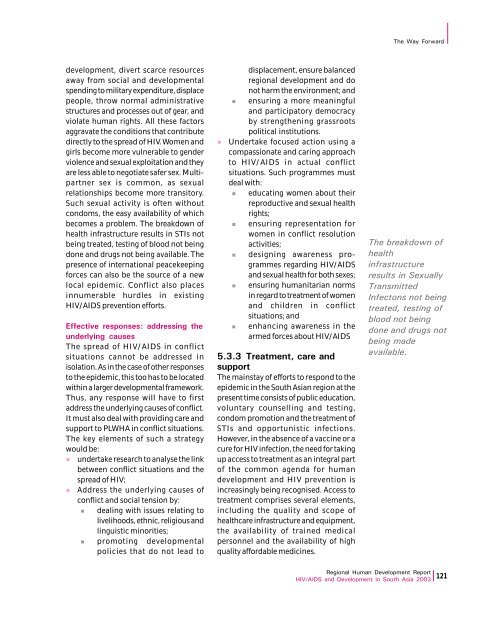Download Report - UNDP Asia-Pacific Regional Centre - United ...
Download Report - UNDP Asia-Pacific Regional Centre - United ...
Download Report - UNDP Asia-Pacific Regional Centre - United ...
You also want an ePaper? Increase the reach of your titles
YUMPU automatically turns print PDFs into web optimized ePapers that Google loves.
The Way orwarddevelopment, divert scarce resourcesaway from social and developmentalspending to military expenditure, displacepeople, throw normal administrativestructures and processes out of gear, andviolate human rights. All these factorsaggravate the conditions that contributedirectly to the spread of HIV. Women andgirls become more vulnerable to genderviolence and sexual exploitation and theyare less able to negotiate safer sex. Multipartnersex is common, as sexualrelationships become more transitory.Such sexual activity is often withoutcondoms, the easy availability of whichbecomes a problem. The breakdown ofhealth infrastructure results in STIs notbeing treated, testing of blood not beingdone and drugs not being available. Thepresence of international peacekeepingforces can also be the source of a newlocal epidemic. Conflict also placesinnumerable hurdles in existingHIV/AIDS prevention efforts.Effective responses: addressing theunderlying causesThe spread of HIV/AIDS in conflictsituations cannot be addressed inisolation. As in the case of other responsesto the epidemic, this too has to be locatedwithin a larger developmental framework.Thus, any response will have to firstaddress the underlying causes of conflict.It must also deal with providing care andsupport to PLWHA in conflict situations.The key elements of such a strategywould be:l undertake research to analyse the linkbetween conflict situations and thespread of HIV;l Address the underlying causes ofconflict and social tension by:n dealing with issues relating tolivelihoods, ethnic, religious andlinguistic minorities;n promoting developmentalpolicies that do not lead toldisplacement, ensure balancedregional development and donot harm the environment; andn ensuring a more meaningfuland participatory democracyby strengthening grassrootspolitical institutions.Undertake focused action using acompassionate and caring approachto HIV/AIDS in actual conflictsituations. Such programmes mustdeal with:n educating women about theirreproductive and sexual healthrights;n ensuring representation forwomen in conflict resolutionactivities;n designing awareness programmesregarding HIV/AIDSand sexual health for both sexes;n ensuring humanitarian normsin regard to treatment of womenand children in conflictsituations; andn enhancing awareness in thearmed forces about HIV/AIDS5.3.3 Treatment, care andsupportThe mainstay of efforts to respond to theepidemic in the South <strong>Asia</strong>n region at thepresent time consists of public education,voluntary counselling and testing,condom promotion and the treatment ofSTIs and opportunistic infections.However, in the absence of a vaccine or acure for HIV infection, the need for takingup access to treatment as an integral partof the common agenda for humandevelopment and HIV prevention isincreasingly being recognised. Access totreatment comprises several elements,including the quality and scope ofhealthcare infrastructure and equipment,the availability of trained medicalpersonnel and the availability of highquality affordable medicines.The breakdown ofhealthinfrastructureresults in SexuallyTransmittedInfectons not beingtreated, testing ofblood not beingdone and drugs notbeing madeavailable.<strong>Regional</strong> Human Development <strong>Report</strong>HIV/AIDS and Development in South <strong>Asia</strong> 2003 121
















